The ASRock X99E-ITX/ac Review: Up to 36 Threads in Mini-ITX
by Ian Cutress on June 24, 2015 8:00 AM ESTCPU Performance
Readers of our motherboard review section will have noted the trend in modern motherboards to implement a form of MultiCore Enhancement / Acceleration / Turbo (read our report here) on their motherboards. This does several things, including better benchmark results at stock settings (not entirely needed if overclocking is an end-user goal) at the expense of heat and temperature. It also gives in essence an automatic overclock which may be against what the user wants. Our testing methodology is ‘out-of-the-box’, with the latest public BIOS installed and XMP enabled, and thus subject to the whims of this feature. It is ultimately up to the motherboard manufacturer to take this risk – and manufacturers taking risks in the setup is something they do on every product (think C-state settings, USB priority, DPC Latency / monitoring priority, memory subtimings at JEDEC). Processor speed change is part of that risk, and ultimately if no overclocking is planned, some motherboards will affect how fast that shiny new processor goes and can be an important factor in the system build.
For reference, the X99E-ITX/ac has Multicore Turbo disabled by default in BIOS P1.20. The important element to note here is if dual channel memory has an effect in performance.
Point Calculations – 3D Movement Algorithm Test: link
3DPM is a self-penned benchmark, taking basic 3D movement algorithms used in Brownian Motion simulations and testing them for speed. High floating point performance, MHz and IPC wins in the single thread version, whereas the multithread version has to handle the threads and loves more cores. For a brief explanation of the platform agnostic coding behind this benchmark, see my forum post here.

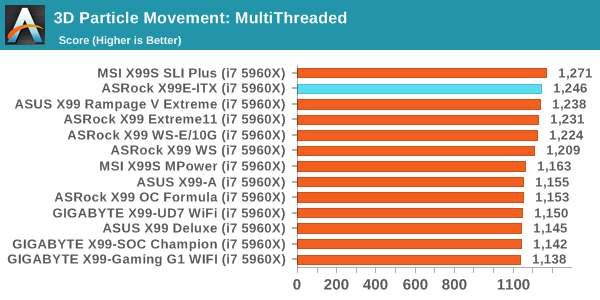
3DPM is not DRAM dependent, so dual channel memory has no issue here.
Compression – WinRAR 5.0.1: link
Our WinRAR test from 2013 is updated to the latest version of WinRAR at the start of 2014. We compress a set of 2867 files across 320 folders totaling 1.52 GB in size – 95% of these files are small typical website files, and the rest (90% of the size) are small 30 second 720p videos.
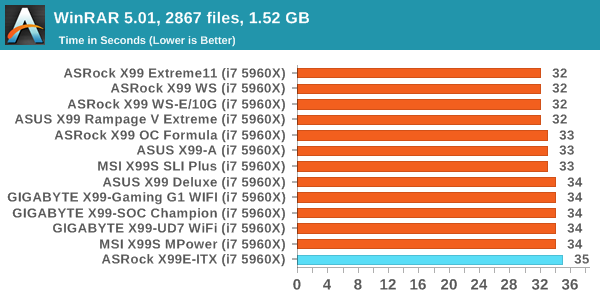
WinRAR is typically a benchmark that tackles DRAM, and we see that the dual channel orientation has a small detriment here.
Image Manipulation – FastStone Image Viewer 4.9: link
Similarly to WinRAR, the FastStone test us updated for 2014 to the latest version. FastStone is the program I use to perform quick or bulk actions on images, such as resizing, adjusting for color and cropping. In our test we take a series of 170 images in various sizes and formats and convert them all into 640x480 .gif files, maintaining the aspect ratio. FastStone does not use multithreading for this test, and thus single threaded performance is often the winner.
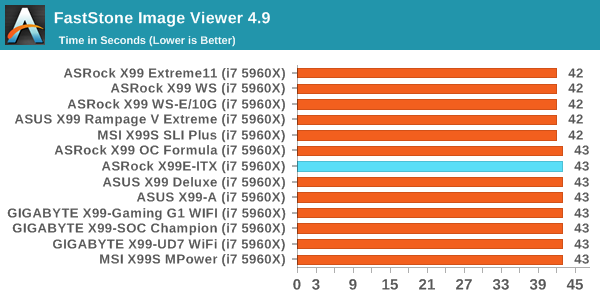
FastStone is a CPU benchmark, so no difference here.
Video Conversion – Handbrake v0.9.9: link
Handbrake is a media conversion tool that was initially designed to help DVD ISOs and Video CDs into more common video formats. The principle today is still the same, primarily as an output for H.264 + AAC/MP3 audio within an MKV container. In our test we use the same videos as in the Xilisoft test, and results are given in frames per second.
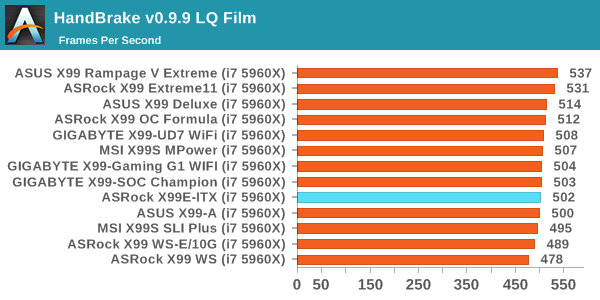
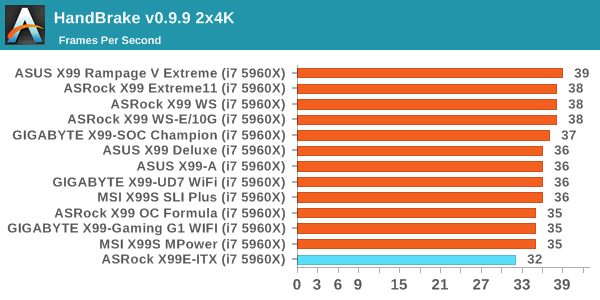
One would normally point at video conversion as requiring DRAM accesses, but we see a difference here between low quality conversion and high quality conversion. Using the larger frames we see that dual channel memory causes a ~10% drop in performance compared to other non-MCE enabled motherboards.
Rendering – PovRay 3.7: link
The Persistence of Vision RayTracer, or PovRay, is a freeware package for as the name suggests, ray tracing. It is a pure renderer, rather than modeling software, but the latest beta version contains a handy benchmark for stressing all processing threads on a platform. We have been using this test in motherboard reviews to test memory stability at various CPU speeds to good effect – if it passes the test, the IMC in the CPU is stable for a given CPU speed. As a CPU test, it runs for approximately 2-3 minutes on high end platforms.
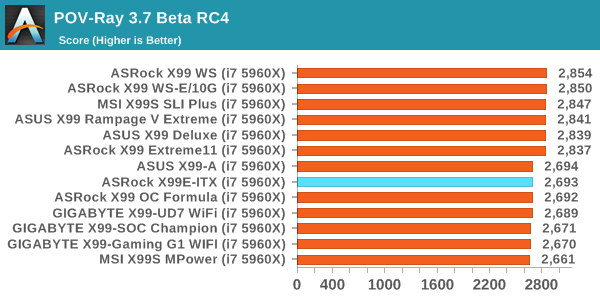
No changes for POV-Ray in dual channel.
Synthetic – 7-Zip 9.2: link
As an open source compression tool, 7-Zip is a popular tool for making sets of files easier to handle and transfer. The software offers up its own benchmark, to which we report the result.
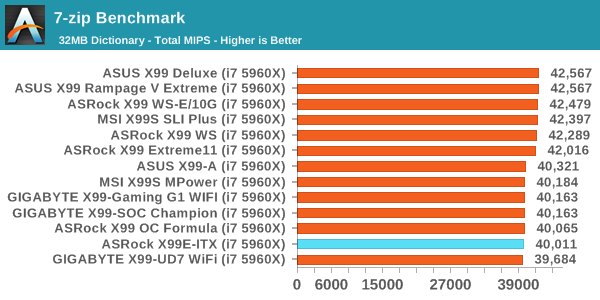
Similarly no difference in 7-zip.










56 Comments
View All Comments
leexgx - Wednesday, June 24, 2015 - link
needs to be DDR4 ECC RDIMM (registered but not buffered) not buffered or Chipkill (the link you posted seems buffered or a chipkill like ram)bebimbap - Wednesday, June 24, 2015 - link
I remember on one of the asrock boards, the z97e itx ac, had its M.2 on the back of the motherboard.With a x99 platform, if you save 16 for the cpu you have at least 12 lanes to work with, so reasonably you could add 3 M.2 slots on the back, or 6 M.2 slots each with pcie3.0-4x.
I understand there is probably a Z height restriction on the back of the board, and probably costs, since you have to plan 2 sides of the board, routing, flexing, etc. However I believe if a M.2 slot can fit, i'm sure most of the transistors and chips such as the sound, LAN, a lot of resistors, wifi, maybe another 2 slots of memory on the back, or all 4, flat of course, and maybe even the PCH with a revised heatsink of course can fit. If more items were on the back of the board, you could fit the CPU socket closer to the pcie slot and allow for all 4 channels of memory. It would be a monster of a rig. 4 channels of ddr4 + 3-6 M.2 pcie3.0x4 in raid0 + pcie3.0x16
Though it might be $400+, I'm sure there would be some interest a fractional proportion to the all out x99 extreme11 series. It would certainly interest me.
WithoutWeakness - Wednesday, June 24, 2015 - link
I love this board. I've had it for a little over a month now running my Plex server/NAS. I had an i5-4440 on an mITX Gigabyte board but it could only handle ~3 1080p transcodes before it started to struggle. Once ASRock released this board I grabbed it and tossed a i7-5820K in and now it has no issues transcoding 6+ streams. I haven't even gotten around to overclocking the 5820K yet.Absolutely amazing how they managed to cram that socket and the powerful VRM solution on this board and still have enough space to fit things like the M.2 slot. ASRock has some impressive engineers on staff. For my use case I needed as many cores as possible in the smallest space as I had already invested in my Node 304 and really didn't want to move to another case. I did need to buy an SFX power supply as I was concerned about my ATX power supply blocking the right-angle SATA ports but that specific issue is due to the layout of the Node 304.
DCide - Wednesday, June 24, 2015 - link
If it's like their mATX board, just start with the slowest (4GHz) OC pre-set in the BIOS. It runs very stably for me.You can fine tune it later if you want to, but in the meantime you can get significant performance benefits right away.
Samus - Thursday, June 25, 2015 - link
I can't wait to get mine. Just ordered it after reading this review, which provided proof of what I suspected all along...quad-channel doesn't provide much in the way of general performance, just like triple-channel didn't provide much performance on X58.Of all the things dual-channel will bottle-neck, the only program I use that would be affected is WinRAR and that's negligible.
ASRock gets a LOT of street cred for making such a bold product. This is the kind of thing DFI or ABIT would have made if they were still around. An ultra-enthusiast, niche, and risky product. It's possible they won't even break even on this considering the amount of engineering that went into it. Margins are already razor thin on motherboards so they need to sell tens of thousands of these to make any money, even at $250 a pop.
BubbaJoe TBoneMalone - Wednesday, June 24, 2015 - link
I'm surprised the other manufacturers are not giving ASRock any competition with their own X99 Mini-ITX motherboard.T1beriu - Wednesday, June 24, 2015 - link
Where's your Fury X review?! :(Where's your Radeon 300 series review?
Have you lost your contacts with AMD PR or lack of time?
Ian Cutress - Wednesday, June 24, 2015 - link
Check the first sentence of the review.just4U - Wednesday, June 24, 2015 - link
Is that something he's been battling for a bit now? We had this flu going around in Canada this past winter that easily throws you for a loop for 3 weeks.. just as you start to think your getting better it knocks you on your ass even worse. Nasty little virus.heh.. he's going to be a busy little beaver.. He mentioned something about the 960 review coming up this week as well.
Samus - Thursday, June 25, 2015 - link
When I get sick, I get sick for weeks, too. Fortunately it's only once a year for me.